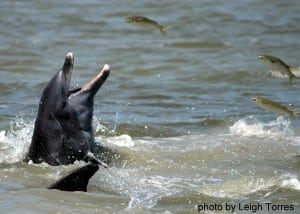Bottlenose Dolphin

Bottlenose dolphin jumping in the Estuary.
Tursiops truncatus
Adult Length Range: 1.9 – 3.8m Light gray to black, fading to white on the belly. They have a short snout extending forward from the melon.

Grab it! A dolphin tries to catch a jumping fish. Photo by Leigh Torres
Bottlenose dolphins (Tursiops truncatus) are the most common marine mammal in the coastal and estuarine waters near Cape Lookout and Beaufort, NC.
Bottlenose dolphin are opportunistic feeders and will hunt whatever is most abundant. They are highly adaptable and congregate in groups. Some males bond in groups of 2 or 3 and mother and calf bonds are usually strong.
Bottlenose Dolphin background and research in North Carolina
North Carolinians have related to dolphins in a variety of ways ranging from commercial dolphin net fisheries (late 1700s-1920s, used primarily for oil, leather, and fertilizer) to conservation of this depleted and federally protected population.

Today, threats to dolphins include unintentional entanglement in commercial and recreational fishing gear, ingestion of litter, contamination of food sources, boat strikes, and intentional (but illegal) feeding of dolphin by boaters.
Researchers at the NC Maritime Museum have been using photo-identification since 1985 to study the local bottlenose dolphins.
